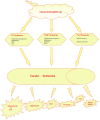Role of Chemerin/ChemR23 axis as an emerging therapeutic perspective on obesity-related vascular dysfunction
- PMID: 35317838
- PMCID: PMC8939091
- DOI: 10.1186/s12967-021-03220-7
Role of Chemerin/ChemR23 axis as an emerging therapeutic perspective on obesity-related vascular dysfunction
Abstract
Sufficient epidemiological investigations demonstrate that there is a close correlation between obesity and vascular dysfunction. Nevertheless, specific mechanisms underlying this link remain currently unclear. Given the crucial and decisive role of vascular dysfunction in multitudinous diseases, various hypotheses had been proposed and numerous experiments were being carried out. One recognized view is that increased adipokine secretion following the expanded mass of white adipose tissue due to obesity contributes to the regulation of vascular function. Chemerin, as a neo-adipokine, whose systemic level is elevated in obesity, is believed as a regulator of adipogenesis, inflammation, and vascular dysfunction via binding its cell surface receptor, chemR23. Hence, this review aims to focus on the up-to-date proof on chemerin/chemR23 axis-relevant signaling pathways, emphasize the multifarious impacts of chemerin/chemR23 axis on vascular function regulation, raise certain unsettled questions to inspire further investigations, and explore the therapeutic possibilities targeting chemerin/chemR23.
Keywords: Adipokine; ChemR23; Chemerin; Obesity; Vascular dysfunction; White adipose tissue.
© 2022. The Author(s).
Conflict of interest statement
There are no conflicts of interest.
Figures



Similar articles
-
Stimulation of non-neuronal muscarinic receptors enhances chemerin/ChemR23 system in dysfunctional endothelial cells.Life Sci. 2013 Jan 17;92(1):10-6. doi: 10.1016/j.lfs.2012.10.029. Epub 2012 Nov 12. Life Sci. 2013. PMID: 23154239
-
The adipokine chemerin amplifies electrical field-stimulated contraction in the isolated rat superior mesenteric artery.Am J Physiol Heart Circ Physiol. 2016 Aug 1;311(2):H498-507. doi: 10.1152/ajpheart.00998.2015. Epub 2016 Jul 1. Am J Physiol Heart Circ Physiol. 2016. PMID: 27371688 Free PMC article.
-
Chemerin/chemR23 axis in inflammation onset and resolution.Inflamm Res. 2015 Feb;64(2):85-95. doi: 10.1007/s00011-014-0792-7. Epub 2014 Dec 30. Inflamm Res. 2015. PMID: 25548799 Review.
-
Chemerin/ChemR23 axis promotes inflammation of glomerular endothelial cells in diabetic nephropathy.J Cell Mol Med. 2019 May;23(5):3417-3428. doi: 10.1111/jcmm.14237. Epub 2019 Feb 19. J Cell Mol Med. 2019. PMID: 30784180 Free PMC article.
-
Vascular effects of perivascular adipose tissue-derived chemerin in obesity-associated cardiovascular disease.Cardiovasc Diabetol. 2025 Jun 13;24(1):249. doi: 10.1186/s12933-025-02814-5. Cardiovasc Diabetol. 2025. PMID: 40514684 Free PMC article. Review.
Cited by
-
Chemerin in the Spotlight: Revealing Its Multifaceted Role in Acute Myocardial Infarction.Biomedicines. 2024 Sep 20;12(9):2133. doi: 10.3390/biomedicines12092133. Biomedicines. 2024. PMID: 39335646 Free PMC article. Review.
-
The Role of Chemerin in Metabolic and Cardiovascular Disease: A Literature Review of Its Physiology and Pathology from a Nutritional Perspective.Nutrients. 2023 Jun 25;15(13):2878. doi: 10.3390/nu15132878. Nutrients. 2023. PMID: 37447205 Free PMC article. Review.
-
Structural basis of G protein-Coupled receptor CMKLR1 activation and signaling induced by a chemerin-derived agonist.PLoS Biol. 2023 Dec 6;21(12):e3002188. doi: 10.1371/journal.pbio.3002188. eCollection 2023 Dec. PLoS Biol. 2023. PMID: 38055679 Free PMC article.
-
Assessing personalized molecular portraits underlying endothelial-to-mesenchymal transition within pulmonary arterial hypertension.Mol Med. 2024 Oct 26;30(1):189. doi: 10.1186/s10020-024-00963-z. Mol Med. 2024. PMID: 39462326 Free PMC article.
-
Role of Chemerin in Cardiovascular Diseases.Biomedicines. 2022 Nov 18;10(11):2970. doi: 10.3390/biomedicines10112970. Biomedicines. 2022. PMID: 36428537 Free PMC article. Review.
References
-
- Stefan N, et al. Metabolically healthy obesity: epidemiology, mechanisms, and clinical implications. Lancet Diabetes Endocrinol. 2013;1(2):152–162. - PubMed
-
- Saxton SN, et al. Mechanistic links between obesity, diabetes, and blood pressure: role of perivascular adipose tissue. Physiol Rev. 2019;99(4):1701–1763. - PubMed
-
- Reilly SM, Saltiel AR. Adapting to obesity with adipose tissue inflammation. Nat Rev Endocrinol. 2017;13(11):633–643. - PubMed
Publication types
MeSH terms
Substances
LinkOut - more resources
Full Text Sources

